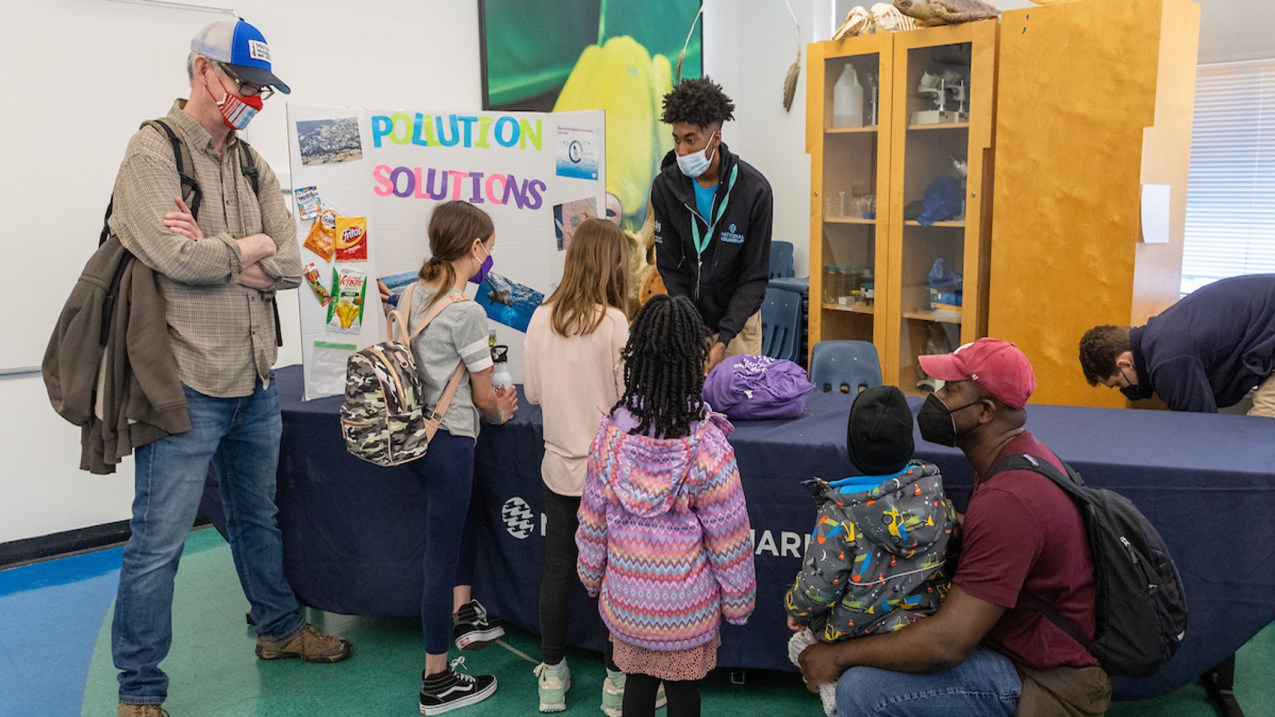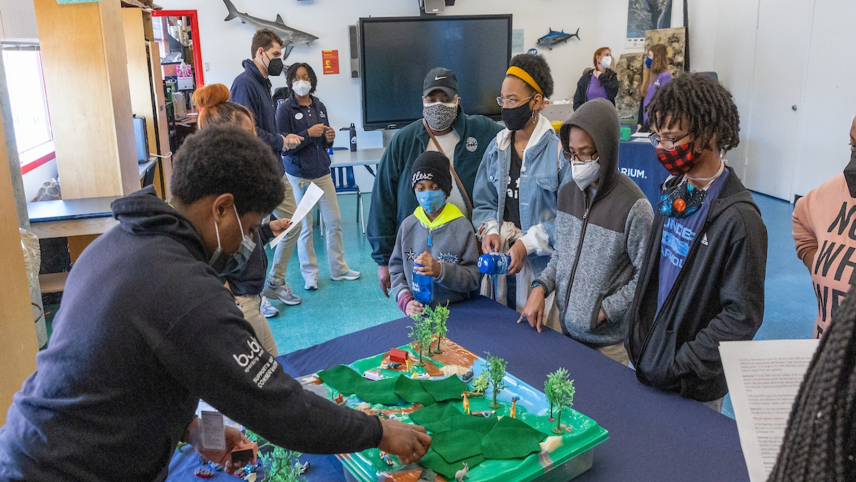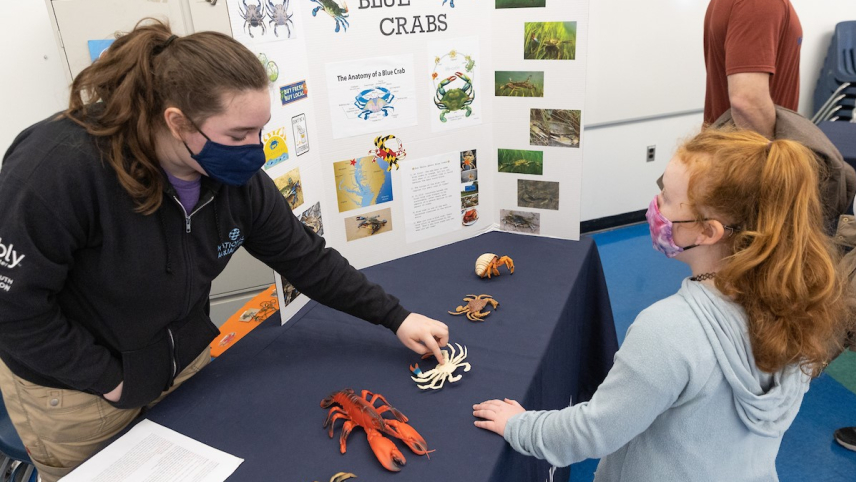Located in the heart of one of America’s oldest seaports, the National Aquarium offsite link in Baltimore, Maryland, inspires and educates more than 1.3 million visitors each year on the ocean’s unique treasures. This institution is one of 25 aquariums and marine science education centers across North America that make up the Coastal Ecosystem Learning Centers (CELC) network. Together this network engages the public in protecting coast and marine ecosystems and work on shared priorities, including youth engagement.

A Henry Hall Fellow from National Aquarium presents on plastic pollution to the attendees of the B'more Conscious, an environmental fun festival. (Image credit: National Aquarium)
The network worked with a team of high school aquarium volunteers to plan the 2021 CELC Virtual Youth Summit, which brought together more than 60 aquarium high school volunteers from the CELC network to hear from speakers on how to make a difference for the ocean through art, writing, advocacy, and more.
Among the attendees of the Virtual Youth Summit were students from the Henry Hall Fellowship offsite link, a paid fellowship program led by the National Aquarium that is open to high school students from Baltimore City and Baltimore County interested in urban conservation and environmental justice. Afterwards, the team of Henry Hall Fellows received funding from NOAA and the North American Association for Environmental Education offsite link to take what they learned to design and lead an action project. The team chose to implement an event to raise awareness on environmental issues impacting their local community. We asked the teens to reflect on their project and what they learned through their experiences. Read what they shared below!
Tell us the story of your project!
We hosted the B’more Conscious, which was an environmental fun festival, on February 21, 2022, in the National Aquarium classrooms. Four stations were created and split between the two classrooms for social distancing. These stations were focused on blue crab populations in Baltimore, plastic pollution and microplastics, eutrophication and food waste, and the urbanization of Baltimore City. Each station used different methods and activities to reach their intended audiences.
Importance of blue crabs
At the blue crab station, guests learned about the importance of blue crabs in Baltimore City’s industries and ecosystems. We had educational activities structured for various age groups and education levels, which ranged from asking young children to identify the blue crab to teaching older children about the Chesapeake Bay food web. Upon completion of the various activities, guests were awarded marine animal stickers.
Impacts of plastic pollution
At the plastic pollution station, guests learned about how plastics break down into microplastics over time and how this affects local marine life. This station aimed to encourage the prevention of plastic pollution through the use of reusable water bottles and shopping bags. We created visual aids detailing the effects of plastic pollution on wildlife and the environment, then provided alternatives to plastic products that promoted the objective of the lesson. Guests created their own reusable shopping bags and decorated reusable water bottles to gain a sense of connection with the issue of plastic pollution.
What to do with food waste
At the eutrophication and food waste station, we discussed the issue of food waste in Baltimore City and other urban environments. We began by asking guests about their experiences with food waste, composting, and garbage before introducing the issues of eutrophication and urban waste disposal. Guests learned which objects can be composted and were encouraged to participate in local compost and food scrap drop-off initiatives. We discussed the importance of composting and proper waste disposal in relation to the preservation of local bodies of water and the prevention of eutrophication in the Chesapeake Bay.

Urbanization of the city
At the urbanization of Baltimore station, we informed guests on the history of Baltimore City and the impact of industrialization and human activity on the coastal environment. To engage participants of all ages, we read a story while demonstrating the process of urbanization using an “EnviroScape” model. As the story began, the “EnviroScape” displayed Baltimore prior to industrialization, showing a greener environment. In order to depict the environmental changes over time, objects including cars, farm animals, people, roads, trees, and boats were placed on the “EnviroScape”. We then offered possible solutions for guests to engage with and prompted participants with questions on the lesson.
How did the project go, and what impact did it have?
In total, 250 guests attended the festival, exceeding the goal we set of 100 guests. The purpose of the event was to bring awareness of environmental issues many Baltimore residents were facing. Overall, there were three main takeaways from this event:
- Guests were more interested in the process of composting than we originally thought, as shown in the data of the post-event survey we asked guests to complete.
- Guests were already aware of the presence of pollution in their local environments, but unaware of how to engage in solving this problem. In the results of the survey, participants indicated that they are actively interested in learning more about these issues and how to mitigate them than originally assumed.
- We were able to improve both our communication skills and how we interacted with younger guests by communicating with guests of varying ages. We also gained a greater sense of confidence in our public speaking skills at the end of the event and feel less nervous about speaking to guests in the future.
How did the project impact you?
Not only did this project bring awareness to the environmental challenges facing Baltimores, the act of designing, implementing, and following through with this project has made an impact on us as a team. We are better able to use the challenges and successes from this event to become better communicators and collaborators, from public speaking to creating meaningful conversations with guests. This experience has allowed us to become advocates for ourselves, and allowed us to step into leadership roles, build budgets, create lesson plans, and work as a part of a team. Finally, being a part of the CELC youth team has helped us to create a closer connection with our community. By choosing an event that allowed us to touch upon multiple subjects, we were able to find out what people needed to hear the most through the results of our survey which was definitely eye opening seeing as though these topics were foreign to many people.

This experience has allowed us to become advocates for ourselves, and allowed us to step into leadership roles, build budgets, create lesson plans, and work as a part of a team.
How did the project impact you?
Not only did this project bring awareness to the environmental challenges facing Baltimore, the act of designing, implementing, and following through with this project has made an impact on us as a team. We are better able to use the challenges and successes from this event to become better communicators and collaborators, from public speaking to creating meaningful conversations with guests. This experience has allowed us to become advocates for ourselves, and allowed us to step into leadership roles, build budgets, create lesson plans, and work as a part of a team. Finally, being a part of the CELC youth team has helped us to create a closer connection with our community. By choosing an event that allowed us to touch upon multiple subjects, we were able to find out what people needed to hear the most through the results of our survey which was definitely eye opening seeing as though these topics were foreign to many people.



